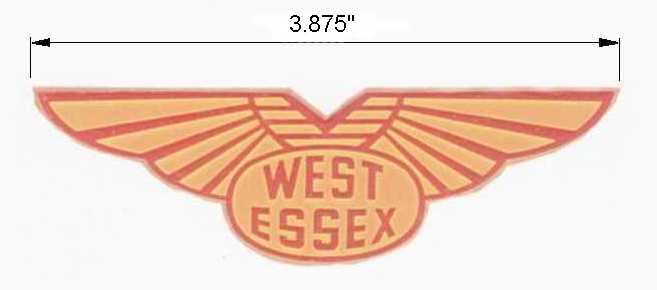Merco engines - the early years
By Bill MorleyOriginally published in 'Model Engine World', October 2002.
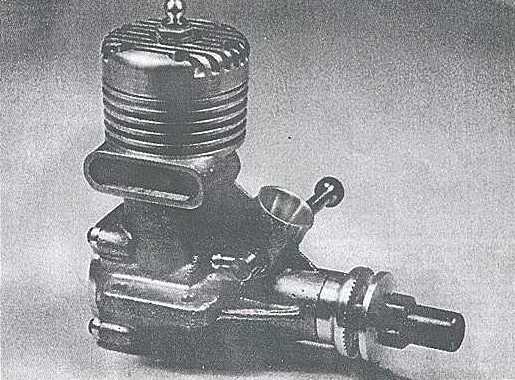
Ron Checkfield's prototype Merco 35.
(All illustrations kindly supplied by Bill Morley.)

Ron Checkfield's prototype Merco 35.
(All illustrations kindly supplied by Bill Morley.)
The origin of Merco Engines was as a direct result of the superb exhibition of CIL aerobatic flying, put on by Bob Palmer at Woburn when he and Howard Bonner visited this country in 1957. I was bowled over by this wonderful display which included manoeuvres such as square inside and outside loops, triangles and square eights, none of which had previously been seen in Britain. Palmer was using his Mk.1 Thunderbird powered by a Veco 35 Series II, and it planted in my mind the thought that maybe there was a niche for the production of this type of motor in this country. Bear in mind that at that time currency restrictions were very strictly enforced and the importation of goods from the USA was nigh on impossible.
Over the next few months the idea grew and in mid-1958 I decided to give it a go. I was no engineer and had no experience in the design of model engines but I had been in the model trade for eight years, chiefly as manager of Henry J Nicholls's shop at 308 Holloway Road, North London and also as sales rep for Alan Hales Ltd. During this time I had developed a large number of contacts and sources.
Enter Ron Checksfield. I'd known Ron for eleven or twelve years and had had a lot of dealings with him in his tuning of team racing engines and we had become good friends. Now, let me state that without Ron the Merco project would never have got off the ground. Sure I had the knowledge of, and the contacts in the model trade, but without Ron's genius all this would have counted for nothing. Similarly, Ron would have needed a contribution like mine to realise the project, but a good number of other people could have provided this. Ron's abilities were essential and unique. However, I have to say that, along with self-interest, there was a fair degree of altruism on my part in recruiting Ron.

Pattern of Merco transfer as supplied with each engine during
Bill Morley's time with the company.
At around thirty years of age, Ron had never had a job. His mother had died when he was quite young, his father had a responsible job and younger brother George was married and had his own place. As a result Ron looked after the home while his father went out to work. Checksfield Snr. had a somewhat unusual job; he was Head Stableman at Whitbread's Brewery in East London, in charge of the teams of show horses and drays which were used for publicity, attending fairs, shows and exhibitions all over Southern England. The teams of great Shire horses and gaily decorated wagons complete with loads of large barrels were a very impressive sight.
My view was that Ron needed to be brought out into the world of work. He had his own well equipped workshop in a room of the house and he was a brilliant self-taught engineer, at least as good as most professional toolmakers. However, his father was pretty advanced in years and I believe was actually past retiring age. He wasn't going to be around for ever and this would leave Ron in a difficult situation for earning a living - very few employers were going to take on somebody who had no work experience whatever. Ron would probably have been forced into some menial job and this would have been a sinful waste of his considerable talents. So it seemed to me that here was an opportunity to get him out of the house and into a suitable occupation while Checksfield pere was still around. The upshot was that I went round to Ron's place and put the scheme to him. Although a very calm individual, he was very enthusiastic and agreed to join at once. From now on Ron enters more and more into the picture. Over the next months a lot of preparational activity went on. The engine had to be designed and a prototype produced and tested. Premises had to be found, machinery to be bought and installed. Drawings to be prepared, contracted-out parts to be laid on. During this time Dennis Allen of AM Engines, who was a friend but had no official connection with the project, helped greatly. He put me in touch with the manufacturers of pressure diecastings and also those of alloy forgings (conrods). He introduced me to father and son Stan and Maurice Hayer who had an engineering firm in Balfour Mews, Lower Edmonton with vacant premises above. Here Dennis had produced his AM engines some years previously. One advantage of locating there was the ability to have parts such as crankshafts, cylinders and pistons produced downstairs by Balfour Engineering, a most convenient arrangement.
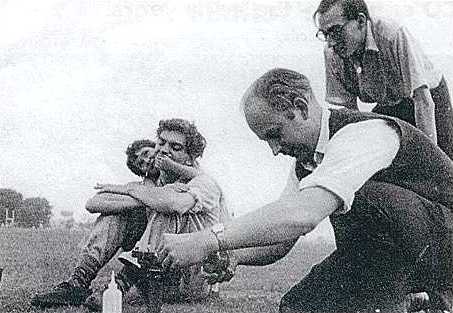
Ron Checksfield testing one of his tuned McCoys at Wanstead Flats in the 1950s.
Ron produced first-rate working, drawings of every part of the engine, to be passed on to manufacturers of contracted-out parts. His multi-view drawings of the pressure die-cast crankcase, cylinder head and rear cover were truly works of art; the dimensions of everything were there. Nothing was left to chance, there was no possibility of error.
I had some clients in Shepherd's Bush who produced high quality sand castings of model railway parts. I arranged with them to make aluminium castings of the crankcase for the prototype engine from Ron's immaculate (what else) wooden pattern. I had two made in case of accidents - I needn't have worried. Ron made what remains the finest stunt engine of all I have ever used. I often wonder what became of it.
I installed it into a Veco Thunderbird which was built for the 1958 Nationals on a typically tight schedule. On the morning of the Gold Trophy I arrived at Waterbeach airfield with the model never having been flown owing to it only having been.finished the night before. A couple of test flights showed the engine to be steady as a rock and with plenty of power. In the Gold Trophy it performed faultlessly, enabling me to come 2nd, only three points behind winner Pete Ridgway. Naturally, Ron and I were delighted. The engine had been a joint design from discussions where I made known to Ron, the requirements for a stunt engine as opposed to the flat-out quest for sheer power predominant in his work on team race and speed motors. Then I left the arcane (to me) stuff like port timings, compression ratio, etc. to him.
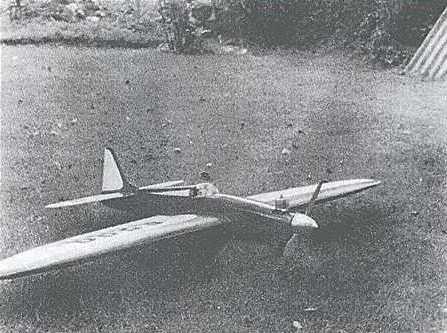
"Pretty ropey shot (on a Box Brownie) of my 1958 Thunderbird equipped with Merco 35
that I flew in that year's Gold Trophy."
After that, it was back to preparation. I bought a new Myford cylindrical grinder, a four jawed independent chuck and dial gauge, a Delapena honing machine, pillar drill, lathe etc. and we got them installed in the workshop. Also to be organised were box design and purchase; advertising; design, compilation and printing of instruction leaflets; waterslide logo transfers and many other details. Meanwhile, Ron designed and made all the tooling required, which was plenty. Also an ingenious test rig for giving the engines their first run, complete with electric starter.
Eventually, at the start of 1959, we got into production. Of course, we had some problems early on, but we soon settled down into a routine. After instruction from Ron I took over operating the grinder, a fine machine enabling me quickly to become accomplished in grinding crankshaft journals and crankpins as well as cylinders and pistons. Initially Ron did all the honing but, after a short while, I shared this with him, honing, pistons into cylinders and crankshafts into main bearings. Both honing and grinding were pleasant, interesting jobs, requiring a good degree of skill. The one job I disliked was the scheduled clean-out of the grinder's slurry tank; this was a dirty, messy and smelly business and I hated it.
Soon, we saw that R/C was the growing market and that we would have to produce a special RIC version of the 35. So Ron came up with conversion incorporating a throttle which in one leap set the standard for all subsequent R/C throttles with its clever adjustable air bleed, much copied over the years.
In view of my 7 years' management of 308 Holloway Road I had given distribution of the engines to Henry Nicholls's wholesale division, Mercury Models, and they did a fine, professional job on our behalf. However, after about 3 years I reviewed things and realised that, although we'd made a lot of engines, we hadn't made any money and things were getting pretty desperate. In fact, we were going down the tubes and three months of low sales would sink us - I stood to lose everything financially. The firm had been undercapitalised from the outset and we had no reserve of cash to enable us to ride out a bad spell. The trouble was that by now currency restrictions had eased and model goods were arriving from America in ever-increasing quantities, thereby diluting our market. Then the clincher arrived with the offer of a job with the KeilKraft organisation and this made up my mind - the firm had to go on the market. I laid it all out to Ron and I'm happy to say he raised no objections, understanding fully the position I was in.
There was, however, one final hand to play. I had been giving thought for some months past to making a super, state of the art R/C engine and it seemed to me that the production of such a motor would make our firm seem highly desirable to a prospective buyer.
It was apparent that the current trend in R/C was towards bigger motors - the engine of choice at that time was the K&B 45, which was nothing more than a bored-out 35. As a result it suffered badly from vibration. Ron and I reckoned we could vastly improve on it. I had been thinking about this for some time and my concept was to eliminate vibration, as far as possible. This would require a sturdily built motor with a heavy bottom end as a stiff platform for the reciprocating mass, which would have to be light. So the crankshaft would be supported by ball races and the piston would be aluminium for lightness and therefore ringed. I did consider rear disc valve induction for a while but decided on front rotary valve as being the more convenient for mounting in an aircraft. The massive construction would lend itself to a 49 sized engine which could be enlarged later on to a 61 without encountering vibration problems.
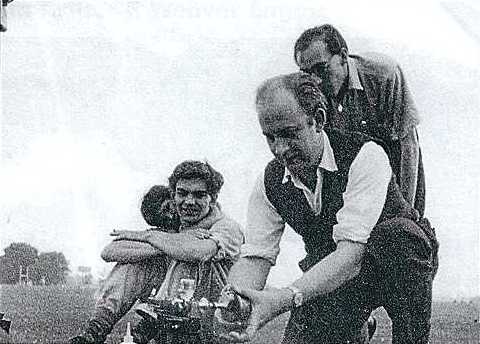
Standing behind Ron is Ivor Roffey, West Essex club speed and teamrace flier.
The engine was probably prepared for him.
I put the proposed specification to Ron and said that, if he approved, he could let rip on the rest of the design and by incorporating his famous throttle it should be a winner. Ron replied that he'd see to it that it would be the best R/C engine in the world which, when it finally appeared, it was.
Things moved on apace; Ron produced drawings and a wooden pattern from which casting's were obtained, piston rings were sourced from Hepworth & Grandage (Hepolite) and bronze-bushed conrods from our forgings suppliers. Ron made 3 prototypes, all of which started literally first flick. Dennis Allen helped speed things up by making the three crankshafts for these engines from drawings supplied by Ron.
Once again, Ron's engine set the standard for all R/C motors from then on - even today's Schneurle ported examples still follow the same basic pattern. one of the prototypes went to Frank Vandenberg. After he had mounted it into his model Ron, Dennis Allen and I went over to Frank's flying field for a demonstration - very impressive. When it was over Frank anxiously enquired, "You're not going to take it away from me now, are you?". We didn't and he went on to win a lot of contests with it.
The Merco 49/61 was to be our last hurrah as a team. Word was out that the business was for sale. Ken Bedford of Eta Instruments was reportedly very keen, but my prime objective was to see that Ron came out of the sale still with a job. He couldn't have commuted from Stepney daily to Watford on his moped, whereas he could do so to Allen Engineering at Upper Edmonton. Dennis was keen to have Ron (and who could blame him?) so the decision was made for me. Ron joined AM/Merco and stayed there from 1961, moving to medical instrument makers Ferrari's Engineering when they bought out AM/Merco some years later. He stayed with Ferrari's when they in turn sold the model engine side to Forest Engineering, until his eventual retirement.
Looking back, I am proud to have started Merco; the engines won a lot of contests including Bob Gialdini's 1963 victory in the U.S. Nationals Open Stunt using a Merco 35 so far as I am aware, still the only British engine to have won this event. I am open to correction if I'm in error here. I also recall Ron turning up at the 1960 British Nationals with a Merco 35 powered Nobler sporting a Checksfield made silencer nearly a foot long. I had several flights with this model and it went through the current schedule with no trouble. Ron Moulton later said in an Aeromodeller editorial that, "You couldn't hear it at all 120 yards downwind." once again Ron C. was years ahead of everybody else.
So, although I started it, only one mon was the real genius behind Merco engines - Ron Checksfield, bless him. I couldn't have done it without him.
Bill Morley - Ongar, July 2002
